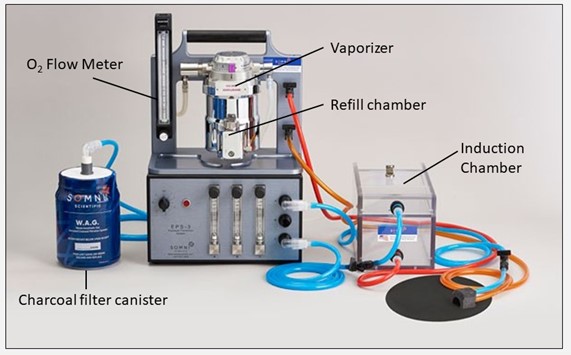WAG stands for Waste Anesthetic Gas. At the National Institutes of Health (NIH), the Division of Occupational Health and Safety (DOHS) oversees the WAG Program. WAGs are excess gasses from anesthesia used during human and animal procedures. Anesthesias are usually combined with oxygen in a vaporizer in which the gas is inhaled by the patient. Air that anesthetized animals or patients breath out can contain WAGs. They can also come from leaks in the anesthesia system.
Common WAGS from procedures at the NIH include halogenated anesthetics and Nitrous oxide (laughing gas). The halogenated anesthetics include Isoflurane/Forane, which is mostly used in animal facilities as well as Sevoflurane, Enflurane and Desflurane. Nitrous Oxide (N2O) is mostly used in dental procedures. The DOHS inspects all anesthesia units at NIH to assess gas leakage and that they are functioning properly and safely. Leaks and improper use of anesthesia equipment can result in exposure.
A typical anesthesia set-up consists of several components. The induction chamber (where the subject is placed to be anesthetized), the vaporizer (which contains an anesthetic gas chamber and holds the container of anesthesia), the Oxygen Flow Meter (adjsuts the oxygen flow rate for patients) and the charcoal filter canister (which filters out any gas from the vaporizer and the induction chamber).

Exposure to WAGs can lead to very serious of side effects. Short term or acute exposure of leaking gases can cause dizziness, headaches, fatigue, nausea and transient blurring of vision. With Long-term or Chronic exposure symptoms can be more severe and personnel may experience additional health problems such as malignant hyperthermia, hypotension, liver damage (hepatotoxicity), and increased risk of miscarriages in pregnant women. Currently it is not believed that common WAGS are carcinogenic.
The goal of the NIH WAG program is to eliminate and/or reduce occupational exposure to WAGs at NIH. To do this, DOHS monitors procedures and equipment to evaluate potential exposure. The DOHS industrial hygienist responsible for surveying procedures and equipment conducts the following safety checks:
WAG Full Survey
- New equipment set-up, including all connections and charcoal filters
- Leak evaluation (i.e., checking for odors)
- Evaluation if sensitive populations are at risk (e.g., pregnant women)
- Using passive dosimeters to determine exposure
WAG Leak Test
- Periodically (every two years)
- Evaluate the effectiveness of engineering controls
- Document and evaluate changes in anesthesia operations (i.e.: equipment, process)
Each unit is tagged after testing. Tags you may see are an identification tag, a tag that shows last testing date, or a tag indicating the unit failed and should not be used.
There will be an updated WAG written program with the upcoming changes below:
- Requirement for site specific SOPs for anesthesia activities
- Requirement to notify WAG manager of major changes in WAG activities (i.e.: change engineering set up, process moved in another location, change in equipment)
- Addition of a spill response plan template
- Updated DOHS WAG fact sheet and poster with a QR code to access more information on the NIH WAG program.
The DOHS WAG Checklist Poster and Fact Sheet can be found here.
Click here for more information.
